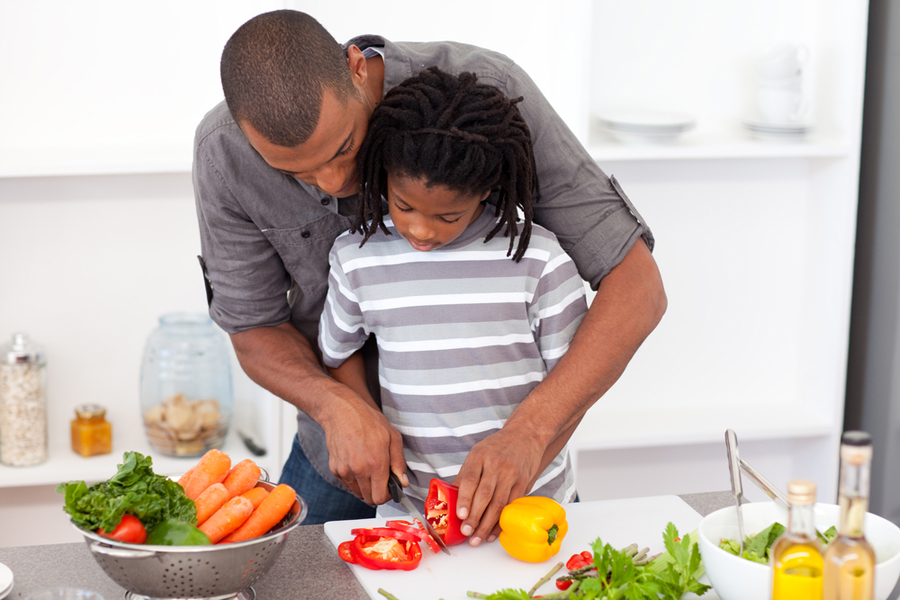We’re big fans of pulling kids into the kitchen early and often. But that also means setting kitchen safety rules for kids — and for you. Not just because it keeps them safe (though that’s obviously the most important thing), but because it’s the essential foundation of learning vital cooking skills that they can use for a lifetime.
And hey, it also lets them help us out around the kitchen too.
The way we see it, there’s no reason why kids as young as 5 years old can’t help make their own school lunch or even help cook breakfast on busy weekday mornings. We even put together a helpful guide to teaching kids cooking skills by age, which is worth a look. Especially with holiday cooking coming up fast, we’ll take any help we can get!

While some kitchen safety rules are obvious, others may be less so, and we love any tools or accessories that help on that front. That’s why we love the idea behind our latest sponsor, Potsafe, a kitchen safety accessory created by two parents who totally get how important it is to get kids in the kitchen while keeping them safe.
Potsafe is designed to help prevent stove burns by locking pots into place on ceramic and glass induction stovetops, as well as on smooth surface cooktops. Smart!
So on their behalf, I’m putting together these 10 important kitchen safety rules that are good to have locked down before you even flick on the kitchen lights.
Hopefully your child will be cooking up a storm — safely — in no time. Good for them and, yes, for you too.
1. Wash hands first. Yes, every time.

Kitchen safety is often discussed in terms of cuts and burns, but foodborne illness is definitely an important concern worth addressing. The number one best way to make sure that kid chefs and their eaters stay safe is to insist that everyone wash hands before cooking and throughout the cooking process. This goes double if you’re working with raw meat or eggs.
2. Tidy yourself, and your space.
Cleanliness actually creates safer cooking conditions, and kids should understand that it applies to both yourself as well as to the kitchen. So before cooking, make sure that everyone in the kitchen securely rolls up loose sleeves (or removes loose clothing altogether) and ties back long hair. You want to avoid anything catching fire, of course, but you also want to avoid catching a sweatshirt sleeve, a loose friendship bracelet, or a long necklace on anything that could tip a hot pot or tug on a sharp knife.
And speaking of loose materials, also be sure that paper towels, kitchen towels, pot holders and other flammable items are kept away from stovetop burners.
3. Rise above it all.
It’s critical to ensure balance and control when working with — or even just around — knives or hot pots and pans. It’s also important to have a clear view of everything that’s going on around you while you cook. But when you’re a kid, that’s not always so easy, especially when the counter is taller than you are! A smart kitchen safety rule is to always have a sturdy, stable, comfortable stool or stepladder of some sort available. Insist that kids hoist themselves up onto this stool so they stand securely above the counter before they embark on any cooking task.
4. Avoid burns.

This rule may be obvious, but some kids are inclined to take shortcuts or get distracted in the kitchen, which can lead to unnecessary burns.
Use potholders: Let them know about the essential need for potholders and oven mitts, and be sure to provide them with ones that fit them properly and grip surfaces well. They should never wad up a kitchen dishtowel to remove a brownie pan from the oven or (yikes) touch a pot handle with bare fingers to see if it’s hot.
(And hey, you follow this rule too, parents! Remember, you are your child’s model for good kitchen behavior.)
Hold onto those handles: If your child is old enough to help with food that’s cooking, also spend some time to make sure they are able to tightly grasp any pot or pan handle while adding to, tossing, or stirring food inside. Part of this is eliminating distractions; if they’re singing along to music, or watching a video on a tablet while carrying a hot pot between the stovetop and sink, then 100% of their attention is not going toward gripping that handle safely.
Talk about what’s hot and what’s not: I also find that kids respond best to kitchen safety rules — or all rules, really — when they understand why you have them in the first place. So it’s a good idea to talk about why pot handles get hot. Have an educational discussion about conductivity, and how anything metal like a colander, the beater on a hand-mixer, or a spoon left too close to a stovetop can be scorching hot, even if it wasn’t in the oven. The same goes for dishware or glass, like a Pyrex baking pan.
If kids do get a burn, Web MD has tips we like. For a minor burn, run cool water (not ice water) over the burn, or cover with a clean towel wet with cold water; then cover with a bandage. No butter!
5. Pot handles: In.
I always tell my kids “no hokey pokey with the pots.” In other words, when it comes to pots and pans on a hot stove, be sure not to turn one handle in and the other one out. Rotate all handles toward the back of the stove. If a handle is poking out into the room, it’s way too easy for them to be accidentally knocked over or grabbed by a younger child. Obviously we want neither of those things to happen, so fortunately, this is one kitchen hazard that’s really easily avoided.
*********************
About our sponsor

Potsafe is an easily assembled kitchen accessory that cleverly locks the included signature pot into place on any ceramic or glass induction stovetop, or smooth surface cooktop. Strong suction cups secure a metal ring to the cooktop surface, and then the pot fits into the ring, which essentially locks it in place.
The pot can still be lifted, lowered, or turned easily, but cannot be pulled off the stove, ensuring that little hands can’t yank scalding food onto the floor (or themselves), helping to keep everyone more safe in the kitchen. Order yours before the end of November to get 10% off and free shipping to mainland USA using the code COOLMOMMA.
*********************
6. Oil and water don’t mix.
This is one of those kitchen safety rules that may be so ingrained in us, we forget to talk to our kids about it. They need to know that when oil is hot, water can cause the oil to splatter or splash back, potentially causing burns. In other words, they shouldn’t copy those chefs on TV who splash a drop of water on an oil-coated pan to see if it’s hot enough.
7. Follow the fire safety plan.
It’s so so so important to talk fire safety of all kinds, but especially in the kitchen. First and foremost, be sure there is a fire extinguisher nearby at all times and that kids know how to use it. If there is a fire though, what’s most critical is that children get an adult’s attention right away, and get out of the area themselves.
If a fire does erupt and it’s small, use baking soda or flour to put it out. But everyone — especially kids — should know that water is not the way to squelch a fire. In fact, it can make a fire bigger. And be sure kids know your family’s evacuation plan, in the case that a fire does get out of control.
While you’re at it, be sure to remind kids about calling 911. You should program the local fire department number into your home phone speed dial or your mobile favorites list, just in case. Better safe than…not safe.
8. Use good knife skills—or skip the knives.

Keep them sharp: Seasoned home cooks know that sharp knives are safer knives. While it may sound counterintuitive, dull knives require the cook to push down harder, increasing the likelihood of dangerous slips. So while you want your little chef to be using a sharp knife, that means they need to have basic knife skills.
Know how to use them: Our guide to teaching kids cooking skills by age recommends chopping as a reasonable task for children 5 years and older (provided they have ample fine motor dexterity) and we have really terrific tips to get you started.
If children are using a knife to help chop, pick a designated spot away from the edge of the counter for them to place the knife when it’s not in use — and to put it down in a way that makes the handle (not the blade) easy to grab when they’re ready to chop again.
The point here is to make sure that the knife isn’t just placed willy nilly where it might slip off the counter or be knocked to the floor. Toe injuries caused by kitchen knives are more common than you’d think. (Eep!)
Consider knife alternatives: If you don’t think that your child is ready to use a knife or you just don’t want them to, consider using kitchen chopping tools that we recommend as alternatives, even for adults. All are great for kids — though skip the mandoline if your child cannot securely hold onto the finger guard.
Every knife in its place: Also, knife safety isn’t over when chopping is over! Be sure you have a designated safe place for everyone to place knives when prep work is done. And no, that doesn’t mean a sink full of water; we don’t want anyone on dishwashing duty risking cuts while reaching into a cluttered sink.
9. Close up shop safely.
Cooking often starts as a calm, fun activity, but can leave even the most seasoned home cooks frazzled and forgetting a few basics at the end. Kids need to remember to “close up shop” properly. That means double-checking that all knives are put away, hot pots and pans are out of reach, slippery spills on the floor are wiped up, and above all, the stovetop and oven are turned off.
If it’s helpful, create an END OF COOKING CHECKLIST and keep it on your fridge door or somewhere on the counter. Away from open flames, of course.
10. If there’s any problem at all, tell a grownup.
Whether it’s a cut, a burn, an olive oil spill, a pot that seems to heavy to handle — it doesn’t matter. Kids need to know that they can always come to you for help without judgment. Basically we know something will go wrong at some point, even if you are there supervising every step of the way, and hopefully it’s minor and provides a good teaching moment. (Ask Liz about the time she was 12 and preheated an oven with oven cleaner in it. That didn’t work out well!)
While we want to encourage independence in our kids, it’s just as important to let them know that you’re there for them any time, especially when it comes to kitchen and cooking safety.
Thank you to our sponsor Potsafe for making thoughtful tools that help busy parents keep kids safer in the kitchen. For more information on Potsafe, check them out on Twitter or visit their website, where you can also place an order for a one-, two-, or three-ring device—including one, two, or three matching pots. Prices start at $59 plus shipping, though if you order yours before the end of November, you’ll get 10% off and free shipping to mainland USA using the code COOLMOMMA.




